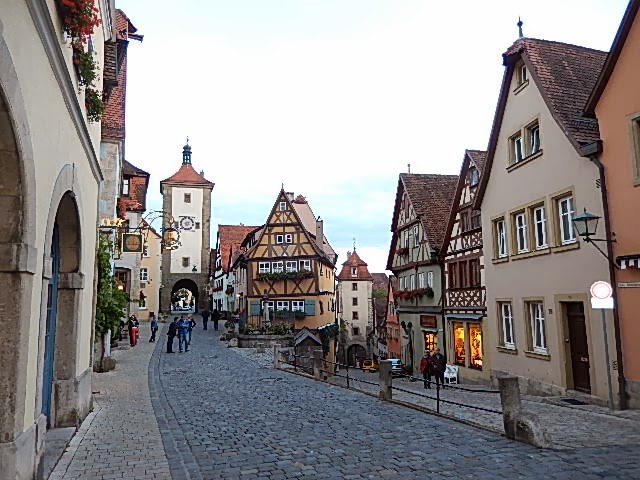Here is the final installment of my European adventure. We arrived back in Amsterdam on Sept. 16 for our flight home on Sept. 19. Therefore, we had some time to do some more exploring. The weather was kind of chilly and damp but that did not deter us. At the left is the Anne Frank home. You cannot truly appreciate the cramped conditions in which they lived unless you actually go through that upper floor. It was a very sobering experience.
My favorite pastime in Amsterdam was strolling along the canals.  There are so many neat little shops and cafes along the way. I can't help but wonder how many cars they have to fish out of these canals! There isn't always a guard rail to stop you. There are flowers everywhere- on the bridges and in window boxes.
There are so many neat little shops and cafes along the way. I can't help but wonder how many cars they have to fish out of these canals! There isn't always a guard rail to stop you. There are flowers everywhere- on the bridges and in window boxes.
 There are so many neat little shops and cafes along the way. I can't help but wonder how many cars they have to fish out of these canals! There isn't always a guard rail to stop you. There are flowers everywhere- on the bridges and in window boxes.
There are so many neat little shops and cafes along the way. I can't help but wonder how many cars they have to fish out of these canals! There isn't always a guard rail to stop you. There are flowers everywhere- on the bridges and in window boxes.
I took this picture to show how some buildings are settling. You can see where one of the buildings is leaning forward. There were many places where either the left side or the right side is higher than its opposite. That probably makes opening a window alittle difficult!
The above picture is the Rijksmuseum which is the Netherlands' national museum. You could easily spend a day going through the exhibits. The highlight is the painting "Night Watch" by Rembrandt. I'm not a real artsy person, but you cannot help but be impressed by seeing the actual works of art that previously you had seen only in pictures, videos, and history books. One interesting sidelight of the museum is that entrance you can see in the picture. The two middle entrances are actually bike lanes that pass through the building. Apparently, the museum director attempted to have those lanes closed to bikes, but the bike "lobby" is so powerful in Amsterdam, it was kept open to bikes. If you could only see how many bikes there are, you could readily understand the power of the bike lobby! The city has a population of 800,000 people and there are 880,000 bikes! Yikes!
This last picture below was an amusing "find" for us. If you cannot read what is inscribed at the top of this structure, I repeated it in the picture's caption. The Latin phrase means "Wise men do not pee into the wind". Why does it say that, you may ask? This was a commercial building project in Amsterdam. The developer was having a lot of difficulties with the permit process. So, he submitted this phrase to the city fathers, who apparently, didn't pay much attention to what it meant and approved it! This was a way for the developer to get back at the city for making the process so difficult!
 |
| Homo Sapiens Non Urinat in Ventum |
Well, the 19th came about and it was time to leave. We took a taxi out to Schiphol International Airport and it was soon off to Chicago on a nine hour flight. We arrived in Chicago around 1 PM and were to have a couple of hours before the connecting flight to Iowa. We got coffee and a newspaper to catch up on the news. I happened to look at the display of flights and noticed that our flight had been canceled along with many others. I will not get into the nitty, gritty of what transpired after that, but I was not a happy camper! My travel partner got to see an irritated side of me that he didn't know existed! We spent from about 2 PM until 8 PM that evening trying to figure out connecting flights and getting accomodations for the night. The next morning, we were on a shuttle from our hotel in Schaumburg, IL back to the airport at 6:30 AM. Got to got through security again.....fun! Finally after a short delay because the flight crew was late in arriving, we were off to the Cedar Rapids airport and the end of a truly amazing trip.




























